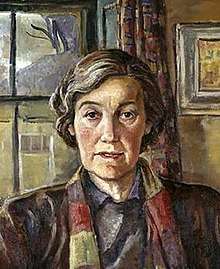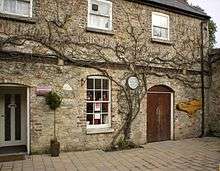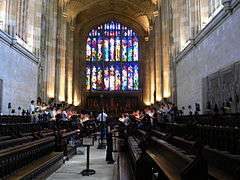Evie Hone
Eva Sydney Hone RHA (22 April 1894 – 13 March 1955), usually known as Evie, was an Irish painter and stained glass artist.[1] She is considered to be an early pioneer of cubism, although her best known works are stained glass. Her most notable pieces are the East Window in the Chapel at Eton College, which depicts the Crucifixion, and My Four Green Fields, which is now in the Government Buildings in Dublin.
Evie Hone | |
|---|---|
 Portrait of Evie Hone by Hilda van Stockum (detail) | |
| Born | Eva Sydney Hone 22 April 1894 Roebuck Grove, County Dublin, Ireland |
| Died | 13 March 1955 Rathfarnham, County Dublin, Ireland |
| Nationality | Irish |
| Education |
|
| Known for | stained glass |

Early life
Hone was born at Roebuck Grove, County Dublin, on 22 April 1894. She was the youngest daughter of Joseph Hone, of the Hone family, and Eva Eleanor, née Robinson, daughter of Sir Henry Robinson and granddaughter of the 10th Viscount Valentia.[2][1] She was related to Nathaniel Hone and Nathaniel Hone the Younger. Shortly before her twelfth birthday[3] she suffered from polio (infant paralysis). She was educated by a governess, continuing her education in Switzerland, and went on tours to Spain and Italy before moving to London in 1913.[4] Her three sisters all married British army officers, and all were widowed in the First World War.[5]
Training
Hone studied at the Byam Shaw School of Art in London and then under Bernard Meninsky at the Central School of Arts and Crafts. She met Mainie Jellett when both were studying under Walter Sickert at the Westminster Technical Institute.[6] She worked under André Lhote and Albert Gleizes in Paris before returning to become influential in the modern movement in Ireland and become one of the founders of the Irish Exhibition of Living Art. She is considered an early pioneer of Cubism but in the 1930s turned to stained glass,[7] which she studied with Wilhelmina Geddes.
Notable works
Her most important works are probably the East Window, depicting the Crucifixion, for the Chapel at Eton College, Windsor (1949–1952) and My Four Green Fields, now located in Government Buildings, Dublin.This latter work, commissioned for the Irish Government's Pavilion, won first prize[8] for stained glass in the 1939 New York World's Fair. It graced CIÉ's Head Office in O'Connell Street from 1960 to about 1983. The East Window of Eton College was commissioned following the destruction of the building after a bomb was dropped in 1940 on the school during the Second World War.[9] The artist was commissioned to design the East Window in 1949, and the new window was inserted in 1952. This work featured on an Irish postage stamp in 1969.[8] From December 2005 to June 2006, an exhibition of her work was on display at the National Gallery of Ireland.
Personal life

Hone was extremely devout; she spent time in an Anglican Convent in 1925 at Truro in Cornwall[4] and converted to Catholicism in 1937. This may have influenced her decision to begin working in stained glass. Initially she worked as a member of the An Túr Gloine stained glass co-operative before setting up a studio of her own in Rathfarnham.
Work in collections or on display

- All Hallows College College Chapel south stained glass window.
- The Crawford Art Gallery, Cork.
- The East Window - Eton College Chapel, Windsor.[10]
- My Four Green Fields - Government Buildings, Dublin.[11]
- Frontage including arms of provinces - Dublin Bus, O'Connell Street, Dublin.[12]
- Lanercost Priory, Cumbria. [13]
- Manresa House, Dublin[14]
- Trinity College Dublin
- East Window, St Mary's Church, Downe, Bromley, Kent.
- The Hugh Lane Municipal Gallery
- Highlanes Gallery Drogheda, Co. Louth.
- Catholic Church in Tullabeg, Co. Offaly: a series of five windows, 1946.
- Church of the Immaculate Conception, Kingscourt, Co. Cavan. Four windows, 1947-8.
- St. Peter and Paul's Church Kiltullagh, Athenry, Co. Galway. Stations of the Cross.
- Church of the Immaculate Conception, Farm Street, London. Rose window in facade and Assumption window, 1953.
- St Michael's, Highgate, London. Stained glass window of The Last Supper dating from 1954.
- Shirley Chapel at Ettington Park, Warwickshire.[15]
- St. John the Baptist, Blackrock, Dublin. Stained glass windows by Evie Hone in 1955.
- SS Michael and John's Roman Catholic Church, Cloughjordan, Co. Tipperary. Two small windows to the side of the altar.[16]
- Holy Family RC Church, Ardara, Co. Donegal. Rose window.
- Mount Carmel Hospital, Churchtown, Dublin. Reception area.
References
- Nicola Gordon Bowe (May 2009). Hone, Eva Sydney (1894–1955). Oxford Dictionary of National Biography, online edition. Oxford: Oxford University Press. doi:10.1093/ref:odnb/33965 (subscription required)
- "General Registrar's Office". IrishGenealogy.ie. Retrieved 22 April 2017.
- "Surprising neglect of famous Irish stained glass artist". The Irish Times. 22 July 2000. Retrieved 8 March 2018.
- Ferriter, Diarmuid. Dictionary of Irish Biography. Cambridge University Press.
- Bourke, Marie (1997). "Evie Hone in Her Studio: Hilda Van Stockum's Portrait". Studies: An Irish Quarterly Review. 86: 165–174.
- Deirdre McMahon (2002). Hone, Evie (1894–1955). in: Anne Commire, Deborah Klezmer (eds.) (2002). Women in World History: A Biographical Encyclopedia. Waterford, CT: Yorkin Publications. Online version: Gale.(subscription required)
- Hillstrom, Kevin (1999). "Evie Hone". In Hillstrom, Laurie Collier; Hillstrom, Kevin (eds.). Contemporary Women Artists. St. James Press. pp. 301–02. ISBN 1558623728.
- Snoddy, Theo (2002). Dictionary of Irish Artists. Merlin Publishing. p. 263. ISBN 1903582172.
- "The Chapel". Eton College website. 8 March 2018.
- "The Eton College website". Archived from the original on 12 March 2007. Retrieved 6 February 2005.
- UCC picture and explanation of Four Green Fields Archived 10 February 2012 at the Wayback Machine
- The Dublin Bus building from Irish-architecture.com Archived 16 March 2005 at the Wayback Machine
- Photographed on Stainedglassphotography.com
- Evie Hone window in the Jesuit Manresa House in Dublin from University College Cork retrieved 22 June 2013
- Hadfield, John (1981). The New Shell guide to England. M. Joseph in association with Rainbird. p. 540.
- "Saints Micheal and John Catholic Church". Cloughjordan. Cloughjordan Development. Archived from the original on 22 July 2012. Retrieved 24 October 2014.
Further reading
- Bruce Arnold (1977), Irish Art, a Concise History (2nd Ed.), London: Thames and Hudson, ISBN 0-500-20148-X
- Nicola Gordon Bowe (2002), Hone, Evie in Brian Lalor (Ed.), The Encyclopedia of Ireland. Dublin: Gill & Macmillan. ISBN 0-7171-3000-2